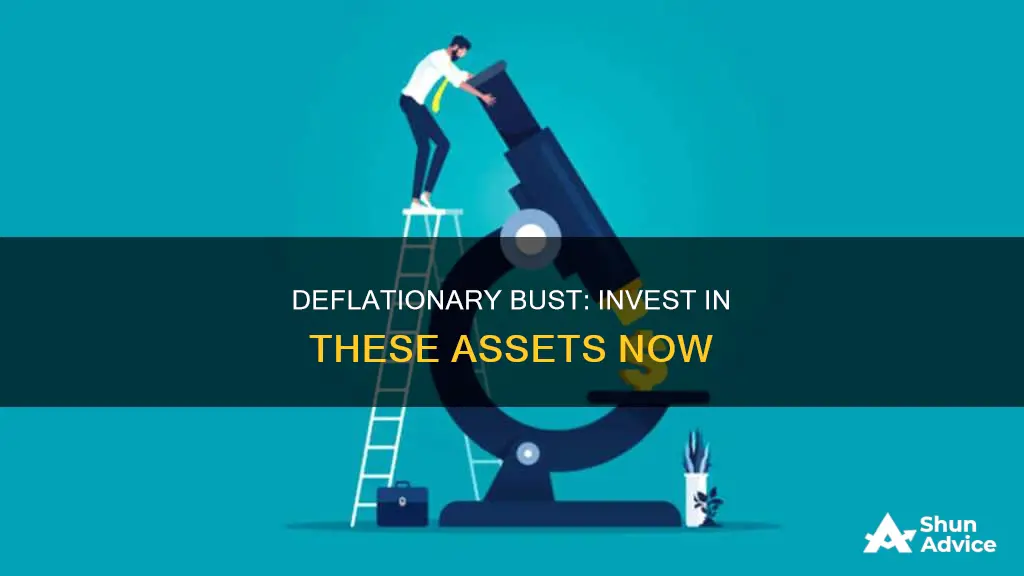
Deflation is a rare occurrence, but it can be detrimental to an economy. It is characterised by a decrease in prices, often coinciding with a recession, and can be triggered by low consumer spending and a decline in demand. During deflation, investors need to be cautious and consider various investment options to protect their portfolios. Here are some strategies to consider when deciding what kind of investments to make during a deflationary bust:
- Investment-grade bonds: These include government-issued bonds and those of high-quality blue-chip companies. They are less risky during deflation due to the stability of the entities behind them.
- Defensive stocks: Stocks of companies that sell essential consumer goods, such as food, toilet paper, and utilities, tend to be more resilient during deflation as people still need to purchase these items regardless of the economic climate.
- Dividend-paying stocks: These remain in demand during a recession as they provide a steady source of passive income, even if the stock price declines.
- Cash and liquid assets: Holding cash and liquid assets, such as certificates of deposits or money market accounts, becomes crucial during deflation as they gain purchasing power and can be easily converted into other investments.
- Gold: Gold tends to retain or increase its value during economic downturns and is often seen as a stable investment option.
What You'll Learn

Build emergency savings
Building an emergency savings fund is a crucial step in preparing for a deflationary bust. Here are some detailed strategies to help you build a robust emergency savings fund:
Understand Your Monthly Expenses:
Start by creating a comprehensive spreadsheet that outlines your monthly expenses. This includes fixed costs such as rent, insurance, utilities, and car payments, as well as variable costs like food, entertainment, and vacations. By doing this, you can gain a clear picture of your financial obligations and identify areas where you can cut back if needed.
Set a Realistic Savings Goal:
Typically, it is recommended to have three to twelve months' worth of living expenses set aside as an emergency fund. However, the exact amount will depend on your personal circumstances, including your age, life stage, job security, and income predictability. For example, if you're in a stable job with a consistent income, you may lean towards the lower end of that range.
Automate Your Savings:
Instead of manually transferring money to your emergency fund now and then, make savings a regular and automated part of your budget. Set up automatic transfers from your paycheck or monthly income to your emergency savings account. Treat your savings contribution as a non-discretionary expense, ensuring that you prioritise building this fund.
Allow for Recreational Spending:
It's important to strike a balance between saving and enjoying your income. Set aside a realistic amount of 'fun money' in your budget for recreational activities. Hold yourself accountable by tracking this spending, and try to avoid the temptation to use credit cards for additional recreational purchases.
Reduce Subscription Services:
Review your monthly expenses, especially subscription-based services, to identify areas where you can cut back. These may include streaming services, gym memberships, or other subscription boxes that you may not be utilising fully. Cancelling unnecessary subscriptions can free up a significant amount of money for your emergency fund.
Explore Additional Income Streams:
Consider ways to bring in extra income to bolster your emergency savings. This could include renting out your home or car temporarily, taking on a side hustle such as food delivery or online reselling, or even working with a tax preparer to ensure you're maximising your tax deductions.
Building an emergency savings fund is a crucial step in financial planning, especially when preparing for economic uncertainties like a deflationary bust. By following these steps, you can ensure that you have a solid financial cushion to fall back on during challenging times.
Invest in CDs: Make Millions with a Safe Strategy
You may want to see also

Be cautious about real estate investments
Real estate investments can be risky during a deflationary period. This is primarily because deflation is characterised by a contraction of money and credit, which can make holding cash more valuable. As a result, deflation can cause a negative compounding effect on wealth, especially if leverage is used.
Leverage, or borrowing money to invest, can be dangerous in a deflationary economy. This is because the value of cash and assets decreases during deflation, but the value of debt remains the same or grows due to accumulated interest. This means that the relative value of cash increases, and the amount of cash required to purchase assets falls. As a result, the purchasing power of money increases, and debt becomes more of a burden.
If you have taken out a mortgage to buy a house, you are using leverage. During a deflationary period, the value of your home may drop, and if you are using leverage, this drop in value is amplified by the amount of leverage used. In addition, your cash flows may decrease, and if you have a mortgage on your investment property, this could pose a problem.
Therefore, it is generally recommended that you do not take out a mortgage during a period of deflation. Instead, it may be better to hold cash reserves and liquid assets, such as certificates of deposits or money market accounts, which can be easily converted into cash.
Using Information to Guide Investment Decisions
You may want to see also

Defensive equities
During a deflationary period, consumers have less money to spend, so they cut down on non-essential purchases. However, people will always need to buy essential goods and services such as food, toilet paper, and electricity, regardless of the economic conditions. Therefore, companies that produce these types of goods and services are likely to continue to receive regular payments from their customers.
If you want to invest in defensive equities but don't want to invest in individual stocks, you could invest in exchange-traded funds (ETFs) that track a consumer goods or utilities index, such as the Dow Jones U.S. Consumer Goods Index or the Dow Jones U.S. Utilities Index. Some popular ETF options for consumer goods include iShares US Consumer Goods (IYK) and ProShares Ultra Consumer Goods (UGE). ETF options for utilities include iShares US Utilities (IDU) and ProShares Ultra Utilities (UPW).
Smart Investment Strategies for 50 Lakh INR in India
You may want to see also

Gold
Historically, gold has been a good investment during deflation. Roy Jastram, a recognised authority on the gold standard, examined three major deflationary periods in US history: 1814-1830, 1864-1897, and 1929-1933. During these periods, gold's purchasing power increased relative to consumer goods. From 1814 to 1830, gold's purchasing power increased by 100% while consumer good prices fell by 50%. From 1864 to 1897, gold's purchasing power rose by 40% while overall prices sank by 65%. Finally, from 1929 to 1933, gold's purchasing power increased by 44% while prices decreased by 31%.
During the Great Depression, the gold price was fixed as most countries were on the gold standard, but as countries went off the gold standard, the gold price surged against most currencies, indicating substantial pent-up demand.
In summary, gold can be a smart investment during deflation, especially when there is a loss of confidence in paper currencies. Its performance is dependent on market sentiment, and it may not always be a perfect hedge, but historically, gold has increased in purchasing power relative to consumer goods during deflationary periods.
Community Investment Managers: Building Bridges, Changing Lives
You may want to see also

Credits
Credit bonds have historically performed well in a deflationary environment, with moderate positive returns. However, there is a question mark over whether they will continue to deliver positive returns in today's economic climate. During the Great Financial Crisis of 2008, credit bonds suffered heavy losses.
In a deflationary environment, the value of cash increases as prices fall. This means that cash is king and those with cash reserves can take advantage of the increasing number of opportunities that will present themselves. For example, cash-rich companies will be able to buy up businesses and resources at bargain prices.
However, debt becomes more of a burden during deflation. As prices fall, the relative value of debt increases. This can lead to a deflationary spiral as people default on their loans, reducing the money supply and credit available, which further reduces demand and prices.
Therefore, it is important to consolidate and repay debt before deflation hits. Balance transfer credit cards can be a good option, as they waive interest fees for a set period, helping you save money and pay off your debt faster.
Overall, while credit bonds have historically performed well during deflation, there is a risk that they may suffer heavy losses as they did in 2008. To protect against this risk, it is important to have a diversified portfolio that includes other deflation hedges such as investment-grade bonds, defensive stocks, dividend-paying stocks, and cash reserves.
Managing Venezuela's Future: Foreign Investment and Aid
You may want to see also







